Pressure build up in gas tank---normal?
#21
Race Director


Member Since: Jan 2003
Location: Summerland B.C. Canada
Posts: 19,667
Likes: 0
Received 36 Likes
on
32 Posts

Curiousity has got me now, so when I get back tomorrow, I will test my 86, so I don't give anyone bad information.

#22
Race Director


I have seen several threads recently asking about fuel tank pressure. This has got my curiosity piqued so I started looking into the evaporative system.
The FSM is pretty vague about how the charcoal canister works (starting on page 6E3-C3-1). It says the solenoid/valve is normally OPEN (when the power is off), except when the ECM commands it to close, which is most of the time. The ECM only opens the valve under certain conditions (warm coolant temperature, minimum vehicle speed, etc.).
There is some kind of mysterious valve mounted on the fuel tank (item 19 "fuel vapor connector" on page 6C-6). Nalley GMC wants $55 for one of these, so I'm not about to buy one to check it out. My guess is that it is a "vapor separator" that feeds liquid fuel back into the tank and only passes fuel vapor through to the charcoal canister. I base that on my experience with my '71 Corvette because it had a vapor separator in a plastic enclosure that cracked and leaked fuel. It was mounted on the top of the fuel tank. I'd love to get my hands on one of these guys so I could see exactly how it works and what it does. I don't want to take my car apart to investigate (too many higher priority things going on right now).
I looked up this "valve" in the parts book and it shows the same part for '84 - '96. It seems to be a very old part because it has a 6 digit part number: 474793. Up through 1990 the descriptions is: CONNECTOR, EVAP EMIS INTER HOSE (THREADS MUST BE COVERED W/TEFLON TAPE). The description from 1991 through 1996 is: CONNECTOR, EVAP EMIS INTER HOSE (THREADS MUST BE SEALED W/THREAD SEALANT 12346004). I found a diagram for a 1982 Corvette fuel tank that calls it a FITTING, FUEL VAPOR PIPE HOSE. I assume INTER means interconnect.
[EDIT] I found one of these things on an '84 Corvette in a junk yard. It is T shaped and the top of the T goes straight through. The part of the T that screws into the gas tank has a pretty small hole in it (about 1/16") [/EDIT]
Also possibly related to this are some threads I've seen with people complaining of running rich for no apparent reason. It appears that if something prevents the charcoal canister valve from closing then the engine will be sucking in fuel vapor all the time. It defaults to open, so this might be where the extra fuel is coming from.
The FSM is pretty vague about how the charcoal canister works (starting on page 6E3-C3-1). It says the solenoid/valve is normally OPEN (when the power is off), except when the ECM commands it to close, which is most of the time. The ECM only opens the valve under certain conditions (warm coolant temperature, minimum vehicle speed, etc.).
There is some kind of mysterious valve mounted on the fuel tank (item 19 "fuel vapor connector" on page 6C-6). Nalley GMC wants $55 for one of these, so I'm not about to buy one to check it out. My guess is that it is a "vapor separator" that feeds liquid fuel back into the tank and only passes fuel vapor through to the charcoal canister. I base that on my experience with my '71 Corvette because it had a vapor separator in a plastic enclosure that cracked and leaked fuel. It was mounted on the top of the fuel tank. I'd love to get my hands on one of these guys so I could see exactly how it works and what it does. I don't want to take my car apart to investigate (too many higher priority things going on right now).
I looked up this "valve" in the parts book and it shows the same part for '84 - '96. It seems to be a very old part because it has a 6 digit part number: 474793. Up through 1990 the descriptions is: CONNECTOR, EVAP EMIS INTER HOSE (THREADS MUST BE COVERED W/TEFLON TAPE). The description from 1991 through 1996 is: CONNECTOR, EVAP EMIS INTER HOSE (THREADS MUST BE SEALED W/THREAD SEALANT 12346004). I found a diagram for a 1982 Corvette fuel tank that calls it a FITTING, FUEL VAPOR PIPE HOSE. I assume INTER means interconnect.
[EDIT] I found one of these things on an '84 Corvette in a junk yard. It is T shaped and the top of the T goes straight through. The part of the T that screws into the gas tank has a pretty small hole in it (about 1/16") [/EDIT]
Also possibly related to this are some threads I've seen with people complaining of running rich for no apparent reason. It appears that if something prevents the charcoal canister valve from closing then the engine will be sucking in fuel vapor all the time. It defaults to open, so this might be where the extra fuel is coming from.
Last edited by Cliff Harris; 09-19-2013 at 02:55 AM. Reason: Added info on valve.
#23
Race Director


Member Since: Jan 2003
Location: Summerland B.C. Canada
Posts: 19,667
Likes: 0
Received 36 Likes
on
32 Posts

Heading to golf, but I did have a little time to do a couple of tests.
I do have a diaphragm beside tank, on the tank line.
Removed rubber hose from tank steel line and blew into in it. Air exists the vent at bottom of tank.
Applied 15" of vacuum to diaphragm on tank line, blew into it again. Even more air exits the vent at bottom of tank.
Thats as far as I got, as it's time to head to the course.
Scrubbing the vapors with charcoal, before venting, still makes sense to me.
If it was totally closed, it would be like trying to fill a coke bottle with a mouth full of smoke, it isn't going to happen unless what is already in the bottle, can be displaced. If the bottle had a hole in the end of it, it would be simple.
If anyone feels the urge, go do a few tests on your own evap.
I will do some more tests, when time permits.
I do have a diaphragm beside tank, on the tank line.
Removed rubber hose from tank steel line and blew into in it. Air exists the vent at bottom of tank.
Applied 15" of vacuum to diaphragm on tank line, blew into it again. Even more air exits the vent at bottom of tank.
Thats as far as I got, as it's time to head to the course.
Scrubbing the vapors with charcoal, before venting, still makes sense to me.
If it was totally closed, it would be like trying to fill a coke bottle with a mouth full of smoke, it isn't going to happen unless what is already in the bottle, can be displaced. If the bottle had a hole in the end of it, it would be simple.
If anyone feels the urge, go do a few tests on your own evap.
I will do some more tests, when time permits.

#24
Race Director


I pulled out my charcoal canister to see what I could see.
The top. CARB BOWL on the right is blocked. FUEL TANK is obvious. PCV goes through the charcoal canister purge valve and connects to an aluminum tube next to the driver's side valve cover that also goes to the PCV valve. It connects to vacuum at the intake manifold next to the cold start injector. I'm pretty sure in '87 and later they connected this vacuum line to the throttle body ported vacuum connection.

The bottom. I had a lot of trouble getting it out because there was a hose (that I couldn't see) attached to this barb fitting. The hose goes under a large wiring harness that won't let it move very much.

The hose that connects to the bottom of the canister. This is not the normal position of the vertical hose (next pic). There is a T at the bottom of the vertical hose just below the label. The label on the hose says 14079283. It's shown in the parts book as HOSE ASM, CNSTR PURGE, made up of 14023108 TEE and HOSE (3/8"), no number given.

The vertical hose goes into this hole in the front next to the wiring harness for the turn signal. It doesn't appear to connect to anything.

The other part of the hose goes over to the curb bumper rail and around the vertical brace. It goes through a hose clamp that holds it in place and you can barely see the end of the hose peeking out from behind the brace (on the right).

I know the engineers must have had a good reason for routing the hose this way, but it's sure not obvious to me...
Here's the whole thing in its normal position. The valve at the bottom (which interestingly is not in Figure C3-3 on page 6E3-C3-3 in the FSM) appears to connect the canister to the fuel tank when the engine is running. The canister purge solenoid and valve are under the shield just to the right of the canister. I get a waterfall from the headlight area when I open the hood after washing my car, so I guess they needed a shield to protect the solenoid.
I just noticed while looking at Figure C3-3 on page 6E3-C3-3 in the FSM that the fuel tank connection to the canister is supposed to be 90° +0° -5° from the bracket gap. That means that mine is in the wrong position (I turned it to make the hoses fit better). That's pretty precise, with a tight tolerance. I wonder what THAT's about...

The top. CARB BOWL on the right is blocked. FUEL TANK is obvious. PCV goes through the charcoal canister purge valve and connects to an aluminum tube next to the driver's side valve cover that also goes to the PCV valve. It connects to vacuum at the intake manifold next to the cold start injector. I'm pretty sure in '87 and later they connected this vacuum line to the throttle body ported vacuum connection.
The bottom. I had a lot of trouble getting it out because there was a hose (that I couldn't see) attached to this barb fitting. The hose goes under a large wiring harness that won't let it move very much.
The hose that connects to the bottom of the canister. This is not the normal position of the vertical hose (next pic). There is a T at the bottom of the vertical hose just below the label. The label on the hose says 14079283. It's shown in the parts book as HOSE ASM, CNSTR PURGE, made up of 14023108 TEE and HOSE (3/8"), no number given.
The vertical hose goes into this hole in the front next to the wiring harness for the turn signal. It doesn't appear to connect to anything.
The other part of the hose goes over to the curb bumper rail and around the vertical brace. It goes through a hose clamp that holds it in place and you can barely see the end of the hose peeking out from behind the brace (on the right).
I know the engineers must have had a good reason for routing the hose this way, but it's sure not obvious to me...
Here's the whole thing in its normal position. The valve at the bottom (which interestingly is not in Figure C3-3 on page 6E3-C3-3 in the FSM) appears to connect the canister to the fuel tank when the engine is running. The canister purge solenoid and valve are under the shield just to the right of the canister. I get a waterfall from the headlight area when I open the hood after washing my car, so I guess they needed a shield to protect the solenoid.
I just noticed while looking at Figure C3-3 on page 6E3-C3-3 in the FSM that the fuel tank connection to the canister is supposed to be 90° +0° -5° from the bracket gap. That means that mine is in the wrong position (I turned it to make the hoses fit better). That's pretty precise, with a tight tolerance. I wonder what THAT's about...
Last edited by Cliff Harris; 08-06-2012 at 01:04 AM. Reason: Added overview pic.
The following users liked this post:
rollin18 (04-25-2020)
#25
Race Director


It's pretty easy to get to the top of the fuel tank if you want to check that stuff too. When I stripped down my car I only found a three way hose connector on top of the tank. It is metal and screws into the top of the tank. There are two hose bards going off the top of it. I remember blowing into it and it didn't appear to have any check valve in it.
One of the lines goes off rubber hose and connects to the hard line that goes to the canister. IIRC the other went to the fuel pump assembly.
One of the lines goes off rubber hose and connects to the hard line that goes to the canister. IIRC the other went to the fuel pump assembly.
#26
Race Director


Member Since: Jan 2003
Location: Summerland B.C. Canada
Posts: 19,667
Likes: 0
Received 36 Likes
on
32 Posts

Cliff , I'm trying to figure out if my canister is bad.
Can you blow through tank line and does it vent out bottom when doing so ?

Last edited by AGENT 86; 08-05-2012 at 01:39 PM.
#27
Burning Brakes


I eliminated that valve that controls the tank pressure...i went to blow air through the tank vent line and popped that sucker right in half. Its right at the bottom of Cliff's last picture. I wonder if I should put this back? I have had 0 problems with the gas cap woosh since I have eliminated this valve.
Mike
Mike
#29
Advanced


Thread Starter
I took a look at my evap system and found that the purge solenoid and the line from the canister to the solenoid was plugged with charcoal. The charcoal obviously came from the canister, so I need a new canister, a new purge valve and need to clear the line running from the canister to the valve. On my car (94), the canister is back by the tank. I have removed the line and am trying to clear the blockage now.
I will need to order the canister and purge valve...here are a few pics.
1994 EVAP routing schematic:
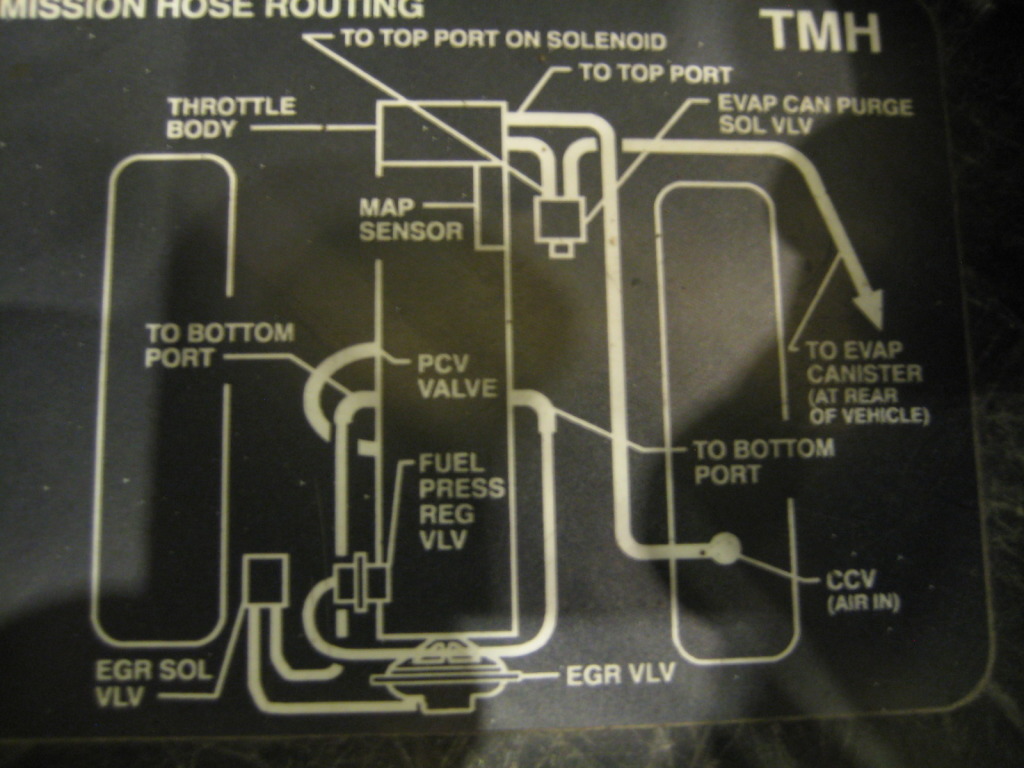
EVAP purge solenoid (right front of intake manifold):
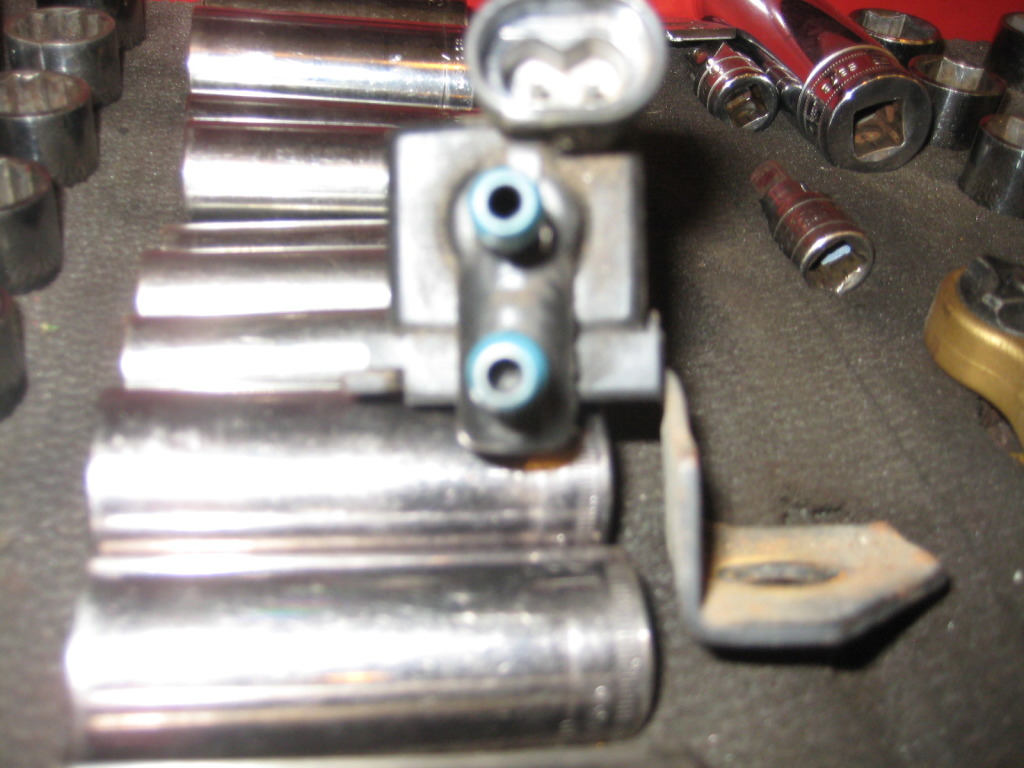
Plugged bottom port of purge valve:
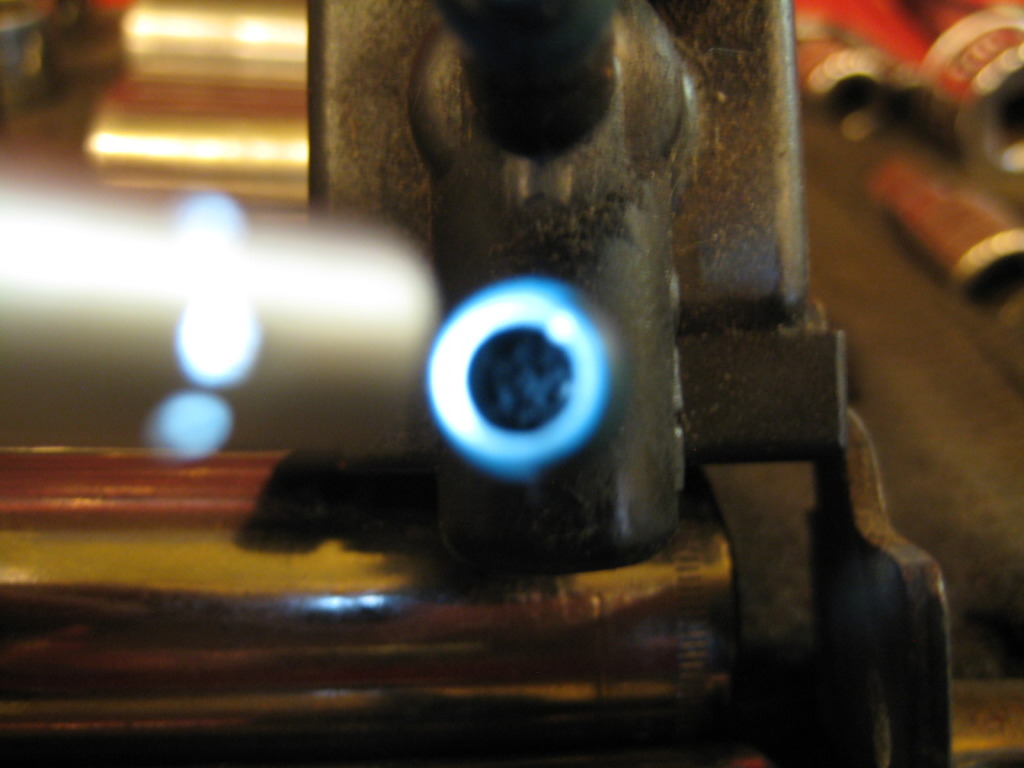
I will need to order the canister and purge valve...here are a few pics.
1994 EVAP routing schematic:

EVAP purge solenoid (right front of intake manifold):

Plugged bottom port of purge valve:

The following users liked this post:
jorgehernan43 (06-30-2019)
#30
Advanced


Thread Starter
I did get the line unplugged. I had to remove it from the car, which (on a 94) requires removal of the passenger side rocker panel cover. It's actually pretty easy to get the cover off and the line out, but unplugging the line was a bit tricky. I used a straightened-out coat hanger and a power drill. I ground a creative end onto the coat hanger to make it act like a (flexable) drill. I had to go in from both ends as deep as I could, then use compressed air from there. I had to keep alternating the compressed air from one end to the other untill the blockage finally blew out.
I will update when I get the new parts installed and tested.
I will update when I get the new parts installed and tested.
#31
Race Director


Years ago I removed the charcoal cannister for some unknown reason I don't remember from one of my cars. I think it was either my '69 Camaro or '71 Corvette. The bottom was basically completely open, with a thing that looked like a filter on the bottom. I guess that was to keep the charcoal in and the dirt out.
#32
Race Director


It's pretty easy to get to the top of the fuel tank if you want to check that stuff too. When I stripped down my car I only found a three way hose connector on top of the tank. It is metal and screws into the top of the tank. There are two hose bards going off the top of it. I remember blowing into it and it didn't appear to have any check valve in it.
One of the lines goes off rubber hose and connects to the hard line that goes to the canister. IIRC the other went to the fuel pump assembly.
One of the lines goes off rubber hose and connects to the hard line that goes to the canister. IIRC the other went to the fuel pump assembly.
I checked the local Pick Your Part web site and they sell the charcoal canisters for $15. I don't know if I want to pay $15 to open up a plastic container full of charcoal granules. I couldn't find anything on that connector. I recall seeing them junk cars years ago and they took the engines and gas tanks out of all the cars before crushing them. Maybe it would be worthwhile to make a visit (in the interest of science).
#33
Race Director


It seems we've drifted away from the original question, which was about fuel tank pressure. It appears from the various posts in this thread that the pressure should be relieved through the vapor canister by the tank pressure control valve (as pointed out by Agent86) whenever the engine is running.
Given that, I had a recent experience with fuel tank pressure that really surprised me. I was driving fairly far from home and the ambient temperature was around 100°. I was pretty low on gas so I found a gas station to fill up. When I loosened the gas cap it whooshed for about 15 - 20 seconds, which seemed like a really long time and I've never had it go that long before. It took over 18 gallons to fill up, so the tank was pretty empty.
I haven't seen anything that says what the gas cap pressure relief pressure is. That will limit how much pressure can build up in the tank (assuming it's functioning properly).
Given that, I had a recent experience with fuel tank pressure that really surprised me. I was driving fairly far from home and the ambient temperature was around 100°. I was pretty low on gas so I found a gas station to fill up. When I loosened the gas cap it whooshed for about 15 - 20 seconds, which seemed like a really long time and I've never had it go that long before. It took over 18 gallons to fill up, so the tank was pretty empty.
I haven't seen anything that says what the gas cap pressure relief pressure is. That will limit how much pressure can build up in the tank (assuming it's functioning properly).
#34
Race Director


Member Since: Jan 2003
Location: Summerland B.C. Canada
Posts: 19,667
Likes: 0
Received 36 Likes
on
32 Posts

I did get the line unplugged. I had to remove it from the car, which (on a 94) requires removal of the passenger side rocker panel cover. It's actually pretty easy to get the cover off and the line out, but unplugging the line was a bit tricky. I used a straightened-out coat hanger and a power drill. I ground a creative end onto the coat hanger to make it act like a (flexable) drill. I had to go in from both ends as deep as I could, then use compressed air from there. I had to keep alternating the compressed air from one end to the other untill the blockage finally blew out.
I will update when I get the new parts installed and tested.
I will update when I get the new parts installed and tested.

When you get your new canister, open it up so we can see what the inside looks like.

Inquiring minds, need to know

#35
Race Director


Member Since: Jan 2003
Location: Summerland B.C. Canada
Posts: 19,667
Likes: 0
Received 36 Likes
on
32 Posts

It seems we've drifted away from the original question, which was about fuel tank pressure. It appears from the various posts in this thread that the pressure should be relieved through the vapor canister by the tank pressure control valve (as pointed out by Agent86) whenever the engine is running.
A clip from my 86 FSM



I removed the hose from the tank pressure control valve and blew through it. Air did come out the bottom of the charcoal cannister.
Years ago I removed the charcoal cannister for some unknown reason I don't remember from one of my cars. I think it was either my '69 Camaro or '71 Corvette. The bottom was basically completely open, with a thing that looked like a filter on the bottom. I guess that was to keep the charcoal in and the dirt out.
Years ago I removed the charcoal cannister for some unknown reason I don't remember from one of my cars. I think it was either my '69 Camaro or '71 Corvette. The bottom was basically completely open, with a thing that looked like a filter on the bottom. I guess that was to keep the charcoal in and the dirt out.
 , it seems like this system is working like I thought.
, it seems like this system is working like I thought. 
#36
Advanced


Thread Starter

I cut it open, but there isn't much to see inside. A lot of granulated charcoal, but thats about it. I see no filters and I can blow either way through both ports. I see that there is some type of check valve on the tank port, but it isn't working. I'll have to check the new canister when it gets here (should be here in about 3 hours). The top of the canister is open to atmosphere and has a cover that acts as a baffle. The port that goes to the purge valve has no check valve or filter. There is also a 3-port valve between the canister and gas tank that doesn't seem to be working correctly as I can blow through all ports in either direction.
The parts list (Oreilly parts store)(remember this is for a 1994):
BWD CP109...check valve...$42
BWD CP313...purge valve...$28
BWD CP1018...canister...$55
I'm more than happy to spend $125 to fix this. Even though it does not affect the drivability of the car, I will feel much better knowing that the EVAP system is working properly.
Here are some pics, the line that was plugged is a hard plastic tube running the length of the car.
WARNING! This is possibly the dirtiest Corvette you have ever seen!
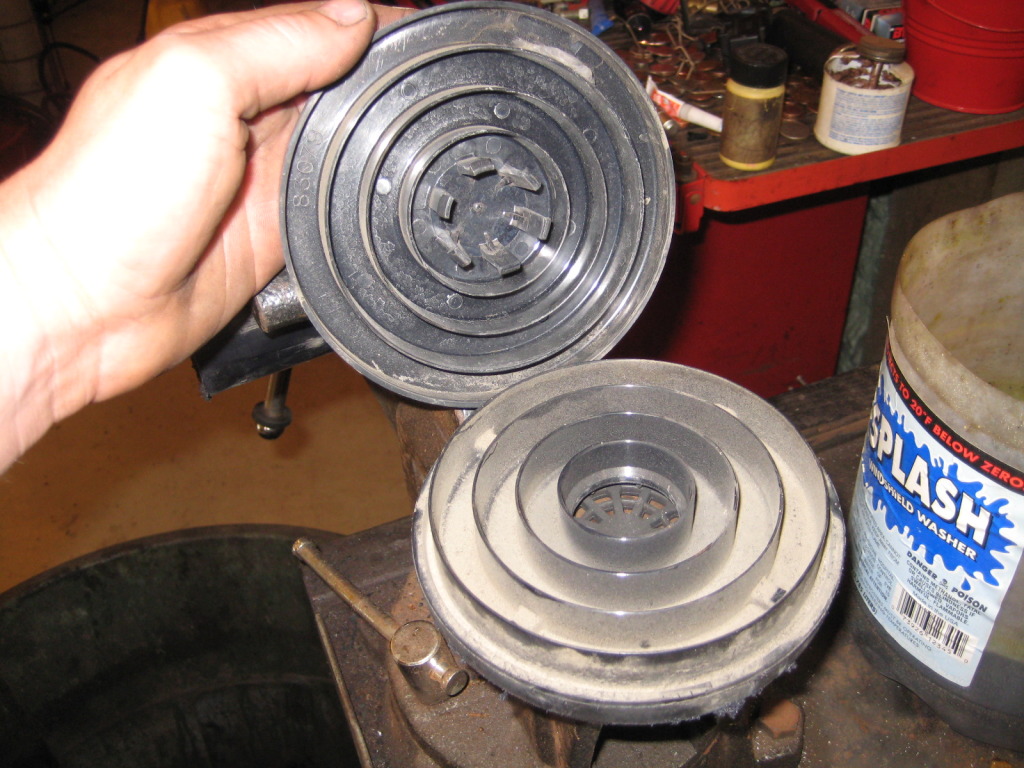
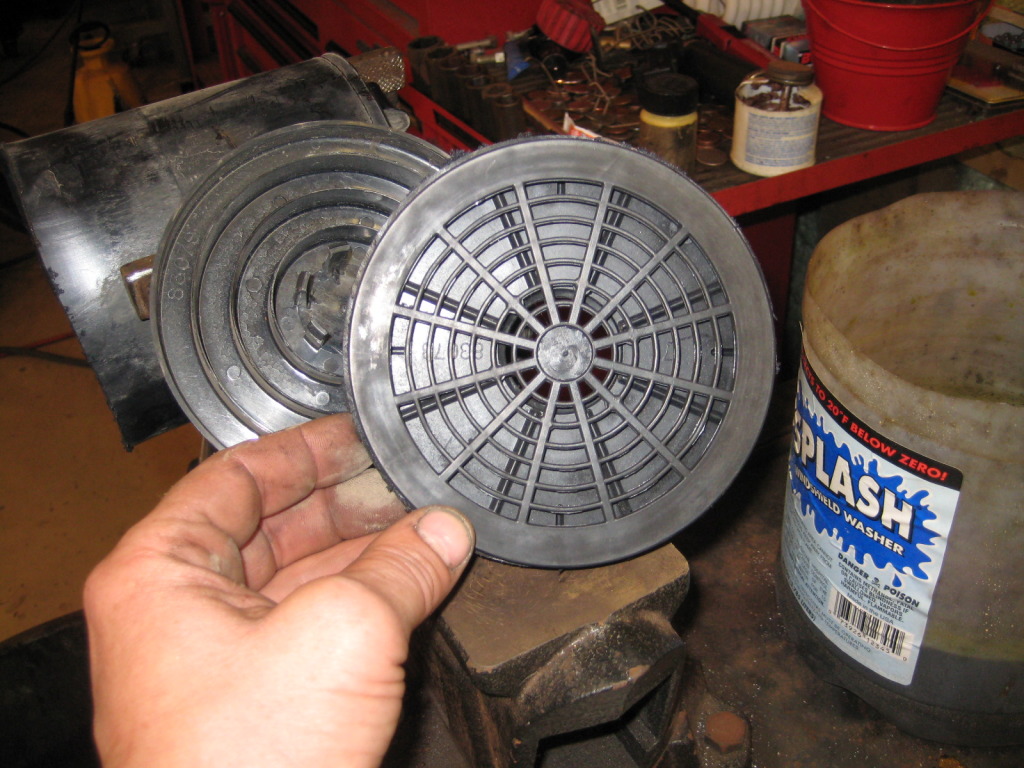

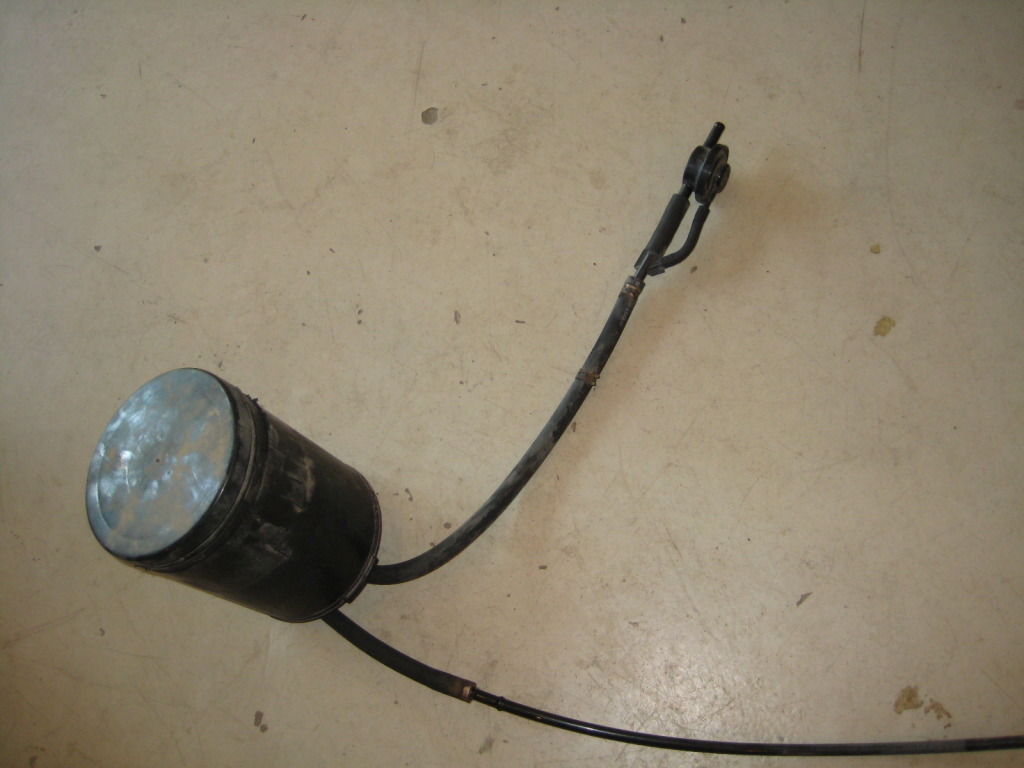
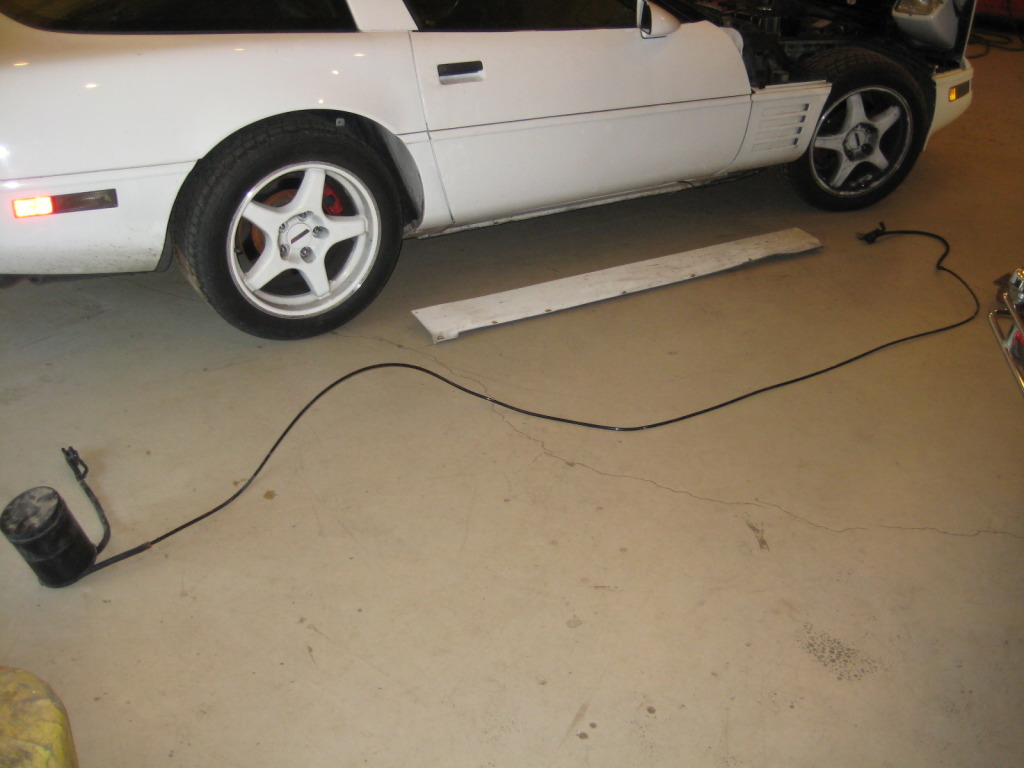
#38
Advanced


Thread Starter
My canister vents through the top only. There are 2 ports on the bottom only. One port goes to the gas tank and the other goes to the line that feeds the purge valve on the engine. I got the new one and it looks identicle to the old one, but there is no type of check valves in it as I can blow either way through either port...same as the old one, but the charcoal is not loose inside.
#40
Le Mans Master


Beg to differ - the Pressure Relief or Tank Valve or whatever you want to call it only bleeds a minute amount of vapor to the canister when it's off. There's a very small restriction that allows this - but it reduces pressure flowing to the canister, it doesn't reduce pressure at the tank. at least not as long as there's gasoline in it and it's cooking up vapors. Pressure at the source remains proportional to temperature and volume.
There are different requirements starting with the initial system which was mandated for 1971, and multiple designs to meet the Law. The latest, applicable to 2000 and above, incorporates vapor recovery into the filler neck which is one of the reasons new cars are a PITA to fill up.
There are 4 elements controlled by the FEDS including (now) fillup vapor control, but basically, none of them allow more than a couple of grams of HC's to vent over 3 days into the atmosphere (and frankly understanding the full extent of the Law probably takes a couple Phd's in Chemistry and Physics).
I don't get what the big deal is. If you live in CA where gas hot water heaters are common to every garage, why in the world would you want gasoline vapors venting from your gas tank??? If that's the case with your car, please park it in the street and stay away from my house!
There seems to be some bad if not impossible science being bandied around here - if you've got a driveability issue, I'd probably give more of a whoosh about that -
There are different requirements starting with the initial system which was mandated for 1971, and multiple designs to meet the Law. The latest, applicable to 2000 and above, incorporates vapor recovery into the filler neck which is one of the reasons new cars are a PITA to fill up.
There are 4 elements controlled by the FEDS including (now) fillup vapor control, but basically, none of them allow more than a couple of grams of HC's to vent over 3 days into the atmosphere (and frankly understanding the full extent of the Law probably takes a couple Phd's in Chemistry and Physics).
I don't get what the big deal is. If you live in CA where gas hot water heaters are common to every garage, why in the world would you want gasoline vapors venting from your gas tank??? If that's the case with your car, please park it in the street and stay away from my house!
There seems to be some bad if not impossible science being bandied around here - if you've got a driveability issue, I'd probably give more of a whoosh about that -



